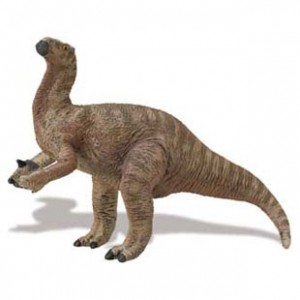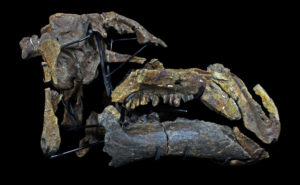Proa valdearinnoensis – The Latest Addition to the Iguanodon Family
The Iguanodon taxon has been much revised over recent years. Palaeontologists have made new fossil discoveries and a number of new genera of these large ornithopods have been erected. Material held within museum collections, particularly in Europe and North America, has been re-examined in the light of recent fossil discoveries and as a result, a number of new genera have been established.
New Iguanodontid Dinosaur
A number of species assigned to the the Iguanodon taxon have been re-assigned and set up as separate genera. An example would be the establishment of Mantellisaurus after a reassessment of iguanodontid material. This genus honours Dr Gideon Mantell, the Victorian scientist who first named and scientifically described Iguanodon (1825).
A Typical Iguanodontid Dinosaur
Picture credit: Everything Dinosaur
The picture (above) shows a model of an Iguanodon, for models and replicas of iguanodontids and other prehistoric animals: Dinosaurs and Prehistoric Animal Figures (Safari Ltd).
Regarded as a taxonomic “waste basket” for a number of years, this reassessment of Iguanodon fossil material has led to the setting up of a number of new genera. The iguanodontid family in Europe has just got a little bigger with the addition of a new, basal iguanodontid from the Teruel Province of eastern Spain. Iguanodonts are a group of “bird-hipped”, ornithischian dinosaurs that first evolved during the Jurassic and went onto become one of the most important and most common groups of herbivorous dinosaurs in the Cretaceous geological period. The name means “Iguana tooth”, after Dr Gideon Mantell noticed the resemblance of some fossil teeth he had found in Sussex (southern England) to the teeth of an extant Iguana lizard.
These facultative bipeds had large bodies, long, stiffened tails, jaws packed with hundreds of blocky shaped teeth and beaks made of horn. Their five fingered hands were quite dexterous for a dinosaur and they are famous for having a “thumb spike” which was probably used in intraspecific conflicts or to defend these herbivores against theropod predators.
Proa valdearinnoensis
Excavations carried out by a team of palaeontologists at a coal mine in Ariño (Teruel Province), led to the discovery of iguanodontid fossil material that represents at least six individual dinosaurs. It total more than 340 dinosaur bones have been found so far, most importantly a number of elements from the skull, including a beautifully preserved and nearly complete specimen of a skull from an adult animal. Studies carried out on the fossils have provided enough evidence for the scientists to establish a new genus of European Iguanodon. The new dinosaur has been named Proa valdearinnoensis. The genus name reflects the shape of the predentary bone, as it reminded the scientists of the shape of a bow on a boat.
Honouring Val de Ariño
The species name honours the location where the fossils were found Val de Ariño, the traditional name for this part of the Teruel region. This particular iguanodontid is distinguished by a very distinctive anatomical feature (autapomorphy), the predentary comes to a point at its tip (the rostral margin). The predentary bone also has upward pointing projections (divergent lateral processes). It is these characteristics that has led to the establishment of a new iguanodontid genus.
A number of specimens, including the best preserved skull material will be put on display at a regional natural history museum. The fossil material was excavated from the Escucha Formation of Teruel Province (eastern Spain).
Fossil Material on Display (Proa valdearinnoensis skull material)
Picture credit: Museo Aragonés de Paleontología
The fossilised bones have been dated to approximately 112 – 110 million years ago (Lower Albian faunal stage of the Cretaceous) and palaeontologists estimate that P. valdearinnoensis would have been about seven to eight metres in length as a fully grown, mature adult.







Leave A Comment